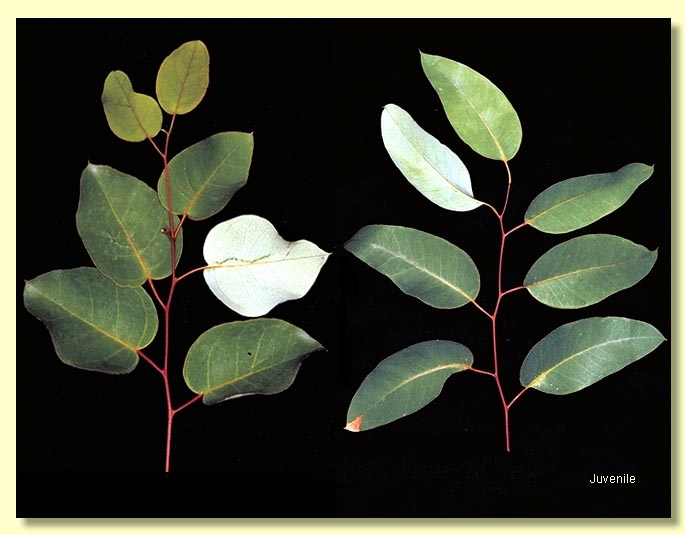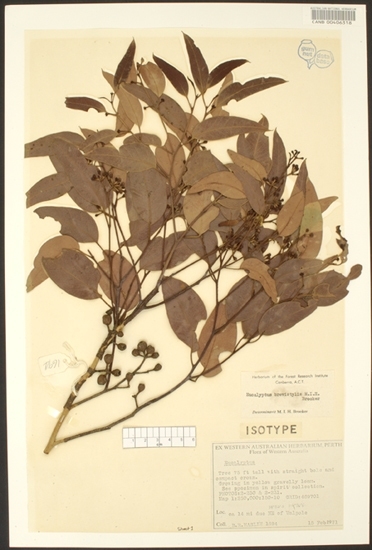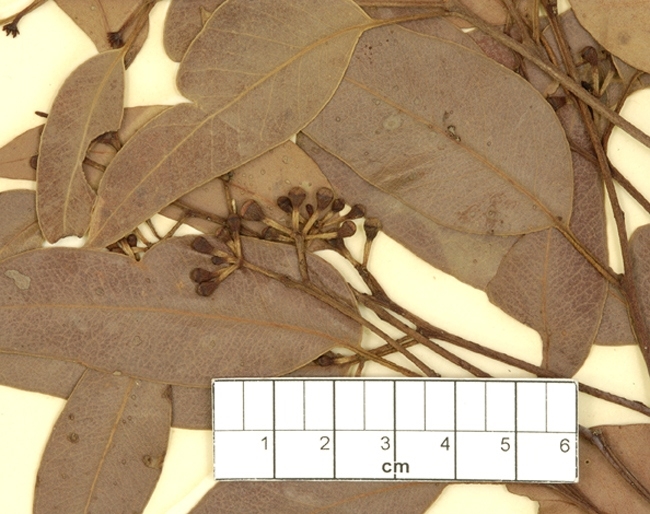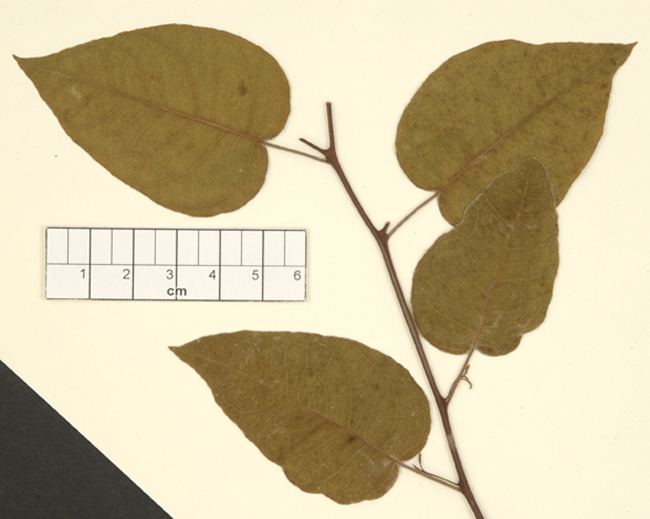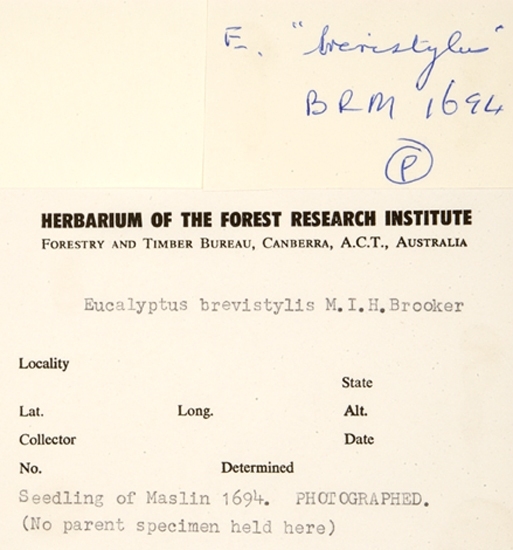Euclid - Online edition
Eucalyptus brevistylis
Eucalyptus | Eucalyptus | Pedaria
Tree to 25 m tall. Forming a lignotuber.
Bark rough to ca 3 cm diameter branches, thick, long-fibred, fissured, tending to papery on the outside, grey-brown over red-brown.
Branchlets usually glaucous; lacking oil glands in the pith.
Juvenile growth (coppice or field seedlings to 50 cm): stems rounded in cross-section, usually glaucous; juvenile leaves always petiolate, opposite for ca 2 nodes then alternate, cordate or ovate, 4–7 cm long, 2.5–6 cm wide, base lobed or less commonly oblique to truncate, discolorous, mid-green above.
Adult leaves thin, alternate, petioles 1–2 cm long; blade lanceolate or slightly falcate, 5.3–9(11) cm long, 1–3 cm wide, base tapering to petiole or oblique, margin entire, apex a drip-tip, discolorous, only slightly glossy, mid-green above, side-veins greater than 45° to midrib, moderately reticulate, intramarginal vein remote from margin, oil glands numerous, large, island.
Inflorescence axillary unbranched, peduncles 0.7–1.4 cm long, buds (7)9, 11 or 13 per umbel, pedicels 0.4–0.7 cm long. Mature buds obovoid to globular, 0.3 cm long, 0.3 cm wide, scar absent, the single operculum rounded, stamens inflexed, staminodes (barren filaments and filaments with small imperfect anthers) present, anthers usually reniform, versatile, dorsifixed, dehiscing by oblique confluent slits, style short, straight, stigma tapered to rounded, locules 3, the placentae each with 2 vertical rows of ovules. Flowers white.
Fruit pedicellate (pedicels 0.3–0.6 cm long), truncate-globose with small orifice, 0.6–1.0 cm long, 0.6–0.9 cm wide, disc descending vertically, valves 3, enclosed.
Seeds brown, 1–3 mm long, pyramidal, dorsal surface curved, minutely roughened, ventral surface ridged, hilum terminal.
Cultivated seedlings (measured at ca node 10): cotyledons reniform; stems rounded in cross-section, glaucous; leaves always petiolate, opposite for 2 to 5 nodes then alternate, ovate-cordate, 2–7 cm long, 1.5–5.5 cm wide, discolorous, mid-green above.
Flowering has been recorded in February, April and May.
A medium-sized to tall tree endemic to Western Australia, restricted lowland sites in wet sclerophyll forests of the Walpole area in the south-west. It is a fully rough-barked tree with discolorous green leaves.
Within its natural range Eucalyptus brevistylis is distinguished from other rough-barked tree species by the combination of axillary inflorescences with buds in clusters of sevens to 1threes, buds with a rounded operculum, short style and outer stamens without anthers (staminodes), and seedling leaves that are always petiolate on glaucous stems and, at least the lower leaves, cordate.
Eucalyptus brevistylis belongs in Eucalyptus subgenus Eucalyptus section Pedaria, characterised by buds with a single operculum (hence no operculum scar), reniform anthers that shed pollen through slits that are confluent apically, ovules arranged in two rows on the placenta, plus the features outlined above. Species in subgenus Eucalyptus fall within two groups depending on how the anthers split to release their pollen. One group, including E. brevistylis , E. marginata, E. staeri and E. jacksonii from Western Australia and the majority of species in subgenus Eucalyptus from eastern Australia, release pollen from the anther through two slits that are apically confluent . The majority of Western Australian species in subgenus Eucalyptus release pollen through two separate (non-confluent) slits in the anther (26 species in this group).
E. brevistylis was not recognised as a species for many years despite the efforts of Forester Jack Rate. The species is rare and may have been cut for timber and mistakenly called Yellow Tingle because of wood similarities.
There are three species of "tingle"— tingle is a forestry term in common usage and is said to be of Aboriginal origin—in the wet forests of the south-west of Western Australia, all rough-barked trees. Two species—Rate's Tingle (E. brevistylis) and Red Tingle (E. jacksonii )—belong to subgenus Eucalyptus, differing in floral and seedling features. The third tingle, E. guilfoylei, is called Yellow Tingle. E. guilfoylei is taxonomically quite unrelated (Eucalyptus subgenus Cruciformes) and differs in having terminal inflorescences, buds with an operculum scar and ovules in four to six rows on the placenta.







